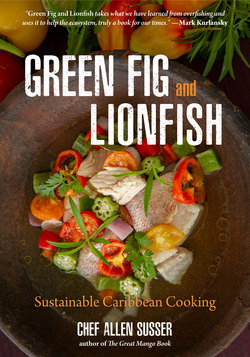Читать книгу Green Fig and Lionfish - Allen Susser - Страница 11
На сайте Литреса книга снята с продажи.
ОглавлениеIntroduction
The story of the lionfish, like all good fish tales, is growing greater each day. These flamboyantly colorful fish with their diverse markings were originally bred in the Indian Ocean. But legend has it that they found their way over to us in the Caribbean when Hurricane Andrew liberated a handful of them from the aquariums of drug lords living in Florida.
Since then, lionfish have bred prolifically in a ceaseless invasion of our seas from Florida to the West Indies. They thrive in the warm waters of the Atlantic and Caribbean and wreak havoc on our ocean ecosystems and fisheries, gobbling up reef fish, juvenile snapper, and grouper. With no known predators to stop them, the lionfish are more threatening than they are beautiful. Not only are they dangerous to fragile ecosystems, they can also inflict an extremely painful sting on humans. Therefore, we need to jump in and put these delicious fish on our dinner plates.
My first encounter with lionfish was at Anse Chastanet in Saint Lucia, where I am the consulting chef for both Anse Chastanet Resort and Jade Mountain. One of the local divers brought in a handful of lionfish from his morning’s catch. We purchase all our fish from local fisherman and usually get our lobster from the divers. This diver was complaining about how these little monsters were eating everything on the reef and destroying the lobster grounds. Would we buy lionfish from him, too?
I had heard of lionfish and was even aware that they were spreading rapidly into the Caribbean. I understood the problems they were causing and, at the same time, was very curious to taste this little creature. And here they were, six of them dangling in front of me, practically dripping with seawater. My chef’s inquisitiveness had gotten the better of me: love at first bite. I was encouraged and enthusiastic. The experience stoked my quest for delicious tasting local sustainable ingredients. And that quest has evolved into this cookbook.
One challenge: catching these things isn’t so easy. Lionfish don’t go for baited hooks, don’t school together, and are well camouflaged against the reefs they populate. Divers spear or net each fish, bringing ashore their bounty in a celebration of sustainability. While lionfish haven’t often appeared on menus in the Caribbean, more restaurants and fishmongers on many islands are beginning to introduce the fish as well as its story as the fish becomes more prevalent in these waters. In Saint Lucia, lionfish are becoming a local commodity. You can find them early mornings in the fish market in town.
You will find this seasonal lionfish cookbook a practical guide to cooking fish. Lionfish fillets are dense, with an elastic bite; a sweet, briny flavor; and just a hint of buttery richness. I like to use lionfish in dishes such as ceviche or simply sautéed with cilantro, garlic, and lime. Delicious grilled, sautéed, or stewed, it’s a near perfect stand-in for many recipes likely in your repertoire already. The key to fish cookery is keeping it fresh and simple. The fresher the fish, the brighter and more honest the flavor. My instinct is to let flavor come through clearly with these simple recipes.
With all due respect for the people of Saint Lucia, I have borrowed the name of this book, Green Fig and Lionfish, from the essence of their namesake, the national dish Green Fig and Saltfish. True to the history of Saint Lucia, mature green bananas are called green figs and play a vital role in daily local cooking. Taking a leap here, I have swapped lionfish for the saltfish that is usually in the pot. I endeavor to not alter the character of the ingredients but to enable them to embody the soulful essence of the Caribbean.
